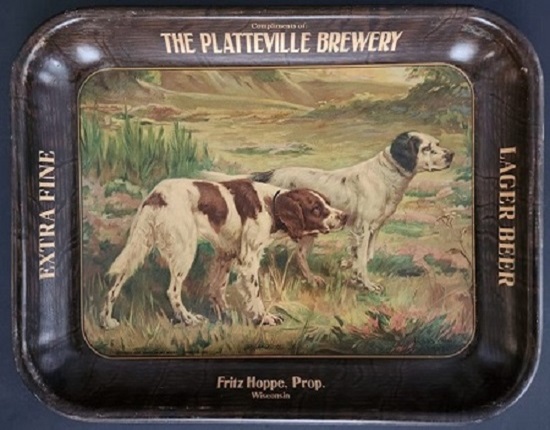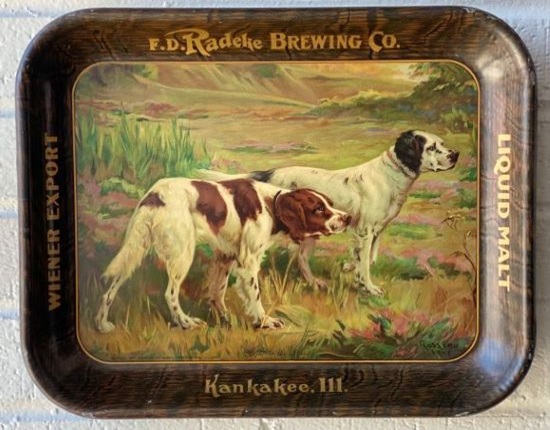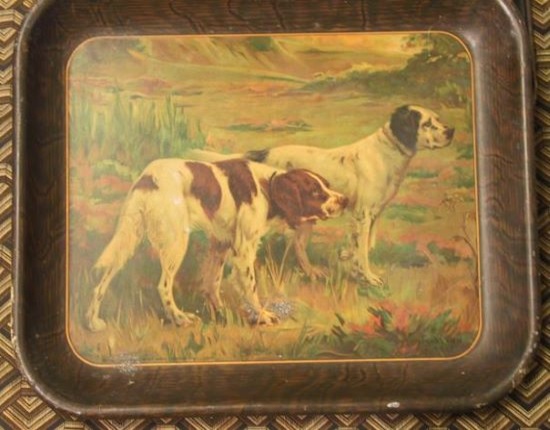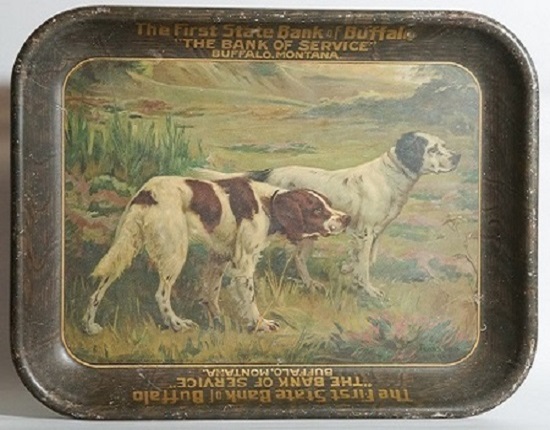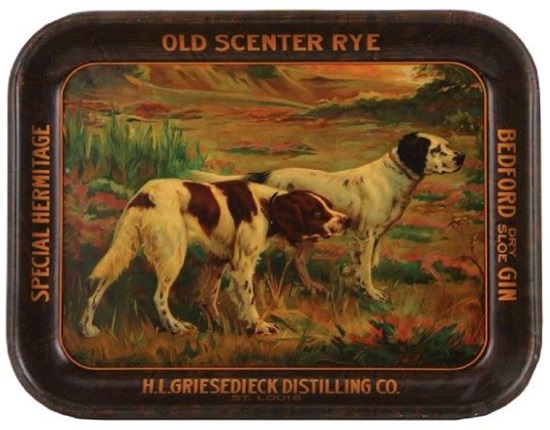The 'Stock' Exchange
American Art Works No. 122 "Right to the Point"
American Art Works No. 122 "Right to the Point"
Date: 1911 - 1912
Size: 13.5" x 10.5"
Type: Pie
Scarcity: Rare
Value: $$$ to $$$$
Condition & Brewer Dependent
Size: 13.5" x 10.5"
Type: Pie
Scarcity: Rare
Value: $$$ to $$$$
Condition & Brewer Dependent



Confirmed Brewer used Stock Trays
Non-Beer Related & Non-Tray Uses
General
No. 122 is one of two designs with the title “Right to the Point” (the other is No. 141). This happened more than once in the Meek/American Art Works era, but we’ve never heard a feasible explanation why this might have occurred. Interestingly, in two cases (the other is “Good Morning,” which is the title of No. 100 and No. 132), one design features dogs and the other a woman (in a third case, “At Your Service,” both designs feature dogs).
There have been a number of designs featuring dogs throughout the catalog; however, this is the first and only known hunting scene. This is a bit surprising since sports hunting reached the height of its popularity in the late 19th and early 20th century with as many as 39 periodicals devoted to the subject. Some scholars believe this occurred due both to nostalgia for a disappearing frontier past and in response to an uptick in immigration often from countries without a strong hunting tradition. Hunting offered an opportunity to demonstrate individualism and ethnic superiority.
The dogs featured in this design appear to be some sort of pointers, a typical bird hunting dog. Their purpose is primarily to help the hunter find game; It takes its name from the stance it adopts when it detects the scent of game, "pointing" at the hidden game as a visible signal to the hunter that it has found something and where it is. They may also be used to flush game from its hiding spot, but generally not to retrieve the game once downed. But looking at different pointer breeds almost all have smooth coats not the longer, rough coats of the dogs in the design. Initially we thought these might be Brittany Spaniels, which is a breed of gun dog bred primarily for bird hunting. Although it is often referred to as a spaniel, the breed's working characteristics are more akin to those of a pointer or setter. Brittanys were developed in the Brittany province of France between the 17th and 19th centuries, becoming officially recognized early in the 20th. However, the most likely breed of these dogs emerged when we looked into the work of the artist.
No. 122 is one of two designs with the title “Right to the Point” (the other is No. 141). This happened more than once in the Meek/American Art Works era, but we’ve never heard a feasible explanation why this might have occurred. Interestingly, in two cases (the other is “Good Morning,” which is the title of No. 100 and No. 132), one design features dogs and the other a woman (in a third case, “At Your Service,” both designs feature dogs).
There have been a number of designs featuring dogs throughout the catalog; however, this is the first and only known hunting scene. This is a bit surprising since sports hunting reached the height of its popularity in the late 19th and early 20th century with as many as 39 periodicals devoted to the subject. Some scholars believe this occurred due both to nostalgia for a disappearing frontier past and in response to an uptick in immigration often from countries without a strong hunting tradition. Hunting offered an opportunity to demonstrate individualism and ethnic superiority.
The dogs featured in this design appear to be some sort of pointers, a typical bird hunting dog. Their purpose is primarily to help the hunter find game; It takes its name from the stance it adopts when it detects the scent of game, "pointing" at the hidden game as a visible signal to the hunter that it has found something and where it is. They may also be used to flush game from its hiding spot, but generally not to retrieve the game once downed. But looking at different pointer breeds almost all have smooth coats not the longer, rough coats of the dogs in the design. Initially we thought these might be Brittany Spaniels, which is a breed of gun dog bred primarily for bird hunting. Although it is often referred to as a spaniel, the breed's working characteristics are more akin to those of a pointer or setter. Brittanys were developed in the Brittany province of France between the 17th and 19th centuries, becoming officially recognized early in the 20th. However, the most likely breed of these dogs emerged when we looked into the work of the artist.
The design is signed “Rousseau” and dated 1907. Initially the only Rousseau we could find was Henri Julien Félix Rousseau was a French post-impressionist painter in the Naïve or Primitive manner but even a quick review of his style made him an unlikely candidate. Finally we stumbled on Percival Leonard Rosseau (1859 - 1937) who as a painter was at the top of his game during the first decades of the 20th century and is best known for his depictions of hunting dogs.
Rousseau was an avid bird hunter and later in life moved his family to an 18th-century home on Grassy Hill in Old Lyme, CT, and turned almost exclusively to painting pointers and English setters. A roomful of paintings of dogs flushing birds and honoring each other’s point might start to resemble each other, but he captured each animal’s unique expression and personality, saying "I cannot remember a single instance of two dogs being similar in character or temperament, and all this variation is reflected in their faces and has to be caught by the painter." The title of many of his paintings include “setters” and a little further comparison of breeds reveals these to be English Setters and in fact, a short 60 second film clip shows him in his dog kennel surrounded by English Setters.
Rousseau was an avid bird hunter and later in life moved his family to an 18th-century home on Grassy Hill in Old Lyme, CT, and turned almost exclusively to painting pointers and English setters. A roomful of paintings of dogs flushing birds and honoring each other’s point might start to resemble each other, but he captured each animal’s unique expression and personality, saying "I cannot remember a single instance of two dogs being similar in character or temperament, and all this variation is reflected in their faces and has to be caught by the painter." The title of many of his paintings include “setters” and a little further comparison of breeds reveals these to be English Setters and in fact, a short 60 second film clip shows him in his dog kennel surrounded by English Setters.
While the original is dated 1907, the design itself carries a copyright of 1910, probably when American Art works acquired rights to the design. Despite that, the design was probably released in 1911, although Sahling has no entry for it.
Size & Shape and Advertising Placement
The few examples we have encountered have all been landscape-oriented small oblongs (11x14) and feature woodgrain rims (like No. 121) with gold advertising text. We have not seen any sign or tip tray versions, although we did encounter a single cardboard print version without any advertising.
Hager & Price
Hager does not discuss this design or include it in his date table, and he does not include it in his catalog presumably because he never encountered an example. For some reason, most of the examples of this design that we’ve encountered have been in below average condition and prices for both brewers and non-brewers have been in double figures or low triple figures. The one exception was an example from F D Radeke Brewing of Kankakee, IA in excellent condition that went for low four figures.
Size & Shape and Advertising Placement
The few examples we have encountered have all been landscape-oriented small oblongs (11x14) and feature woodgrain rims (like No. 121) with gold advertising text. We have not seen any sign or tip tray versions, although we did encounter a single cardboard print version without any advertising.
Hager & Price
Hager does not discuss this design or include it in his date table, and he does not include it in his catalog presumably because he never encountered an example. For some reason, most of the examples of this design that we’ve encountered have been in below average condition and prices for both brewers and non-brewers have been in double figures or low triple figures. The one exception was an example from F D Radeke Brewing of Kankakee, IA in excellent condition that went for low four figures.
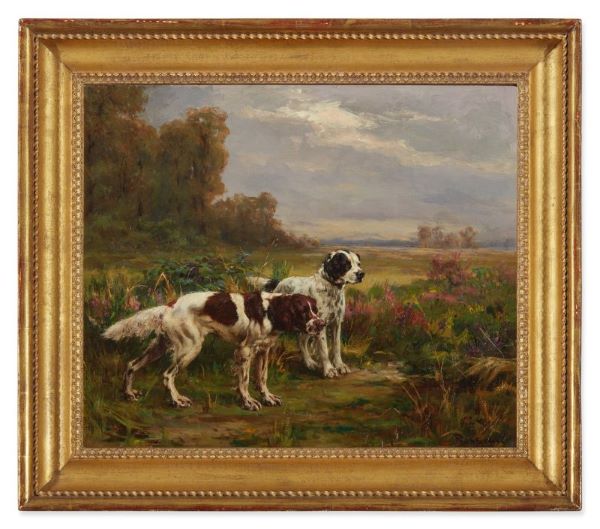
Click the Picture to Return to Meek & Beach Stock Catalog Page
